University Report: Quality Improvement Initiative on Hand Washing
VerifiedAdded on 2022/10/15
|5
|1150
|13
Report
AI Summary
This report details a quality improvement initiative centered around promoting hand washing as a crucial practice for preventing the spread of infections. It highlights the significance of hand hygiene in reducing the risk of diseases, emphasizing that regular hand washing is a cost-effective and access...
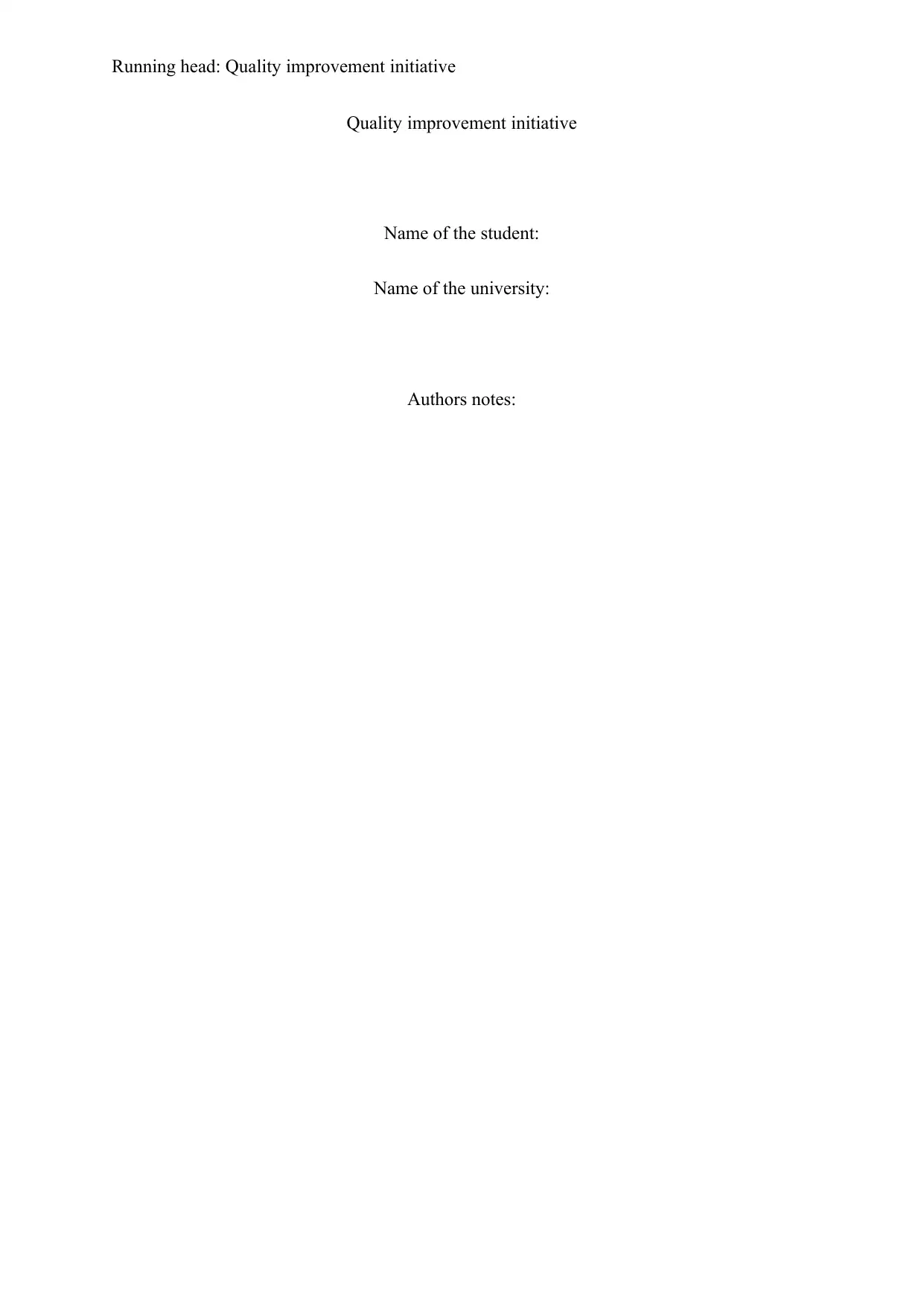
Running head: Quality improvement initiative
Quality improvement initiative
Name of the student:
Name of the university:
Authors notes:
Quality improvement initiative
Name of the student:
Name of the university:
Authors notes:
Secure Best Marks with AI Grader
Need help grading? Try our AI Grader for instant feedback on your assignments.
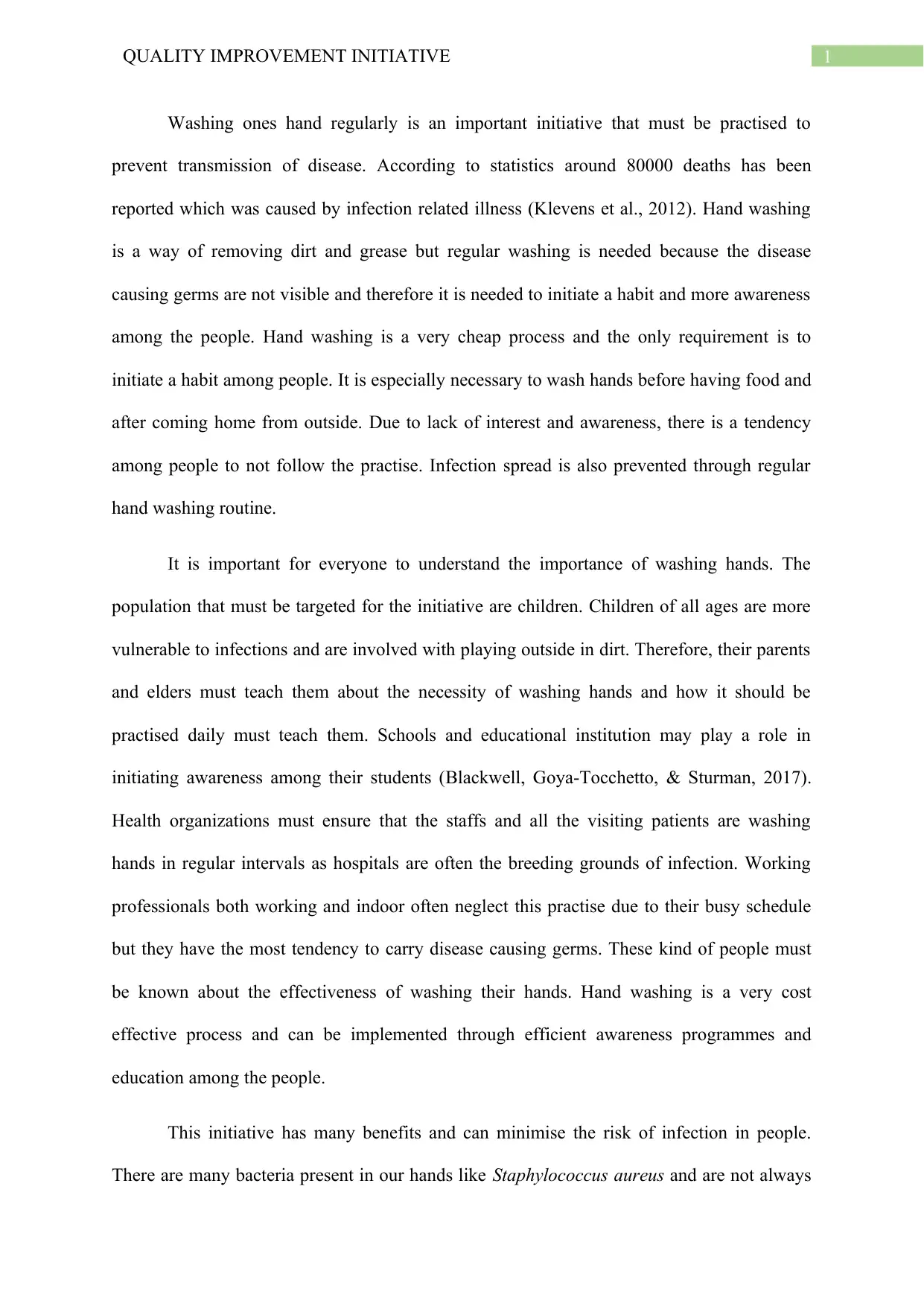
1QUALITY IMPROVEMENT INITIATIVE
Washing ones hand regularly is an important initiative that must be practised to
prevent transmission of disease. According to statistics around 80000 deaths has been
reported which was caused by infection related illness (Klevens et al., 2012). Hand washing
is a way of removing dirt and grease but regular washing is needed because the disease
causing germs are not visible and therefore it is needed to initiate a habit and more awareness
among the people. Hand washing is a very cheap process and the only requirement is to
initiate a habit among people. It is especially necessary to wash hands before having food and
after coming home from outside. Due to lack of interest and awareness, there is a tendency
among people to not follow the practise. Infection spread is also prevented through regular
hand washing routine.
It is important for everyone to understand the importance of washing hands. The
population that must be targeted for the initiative are children. Children of all ages are more
vulnerable to infections and are involved with playing outside in dirt. Therefore, their parents
and elders must teach them about the necessity of washing hands and how it should be
practised daily must teach them. Schools and educational institution may play a role in
initiating awareness among their students (Blackwell, Goya-Tocchetto, & Sturman, 2017).
Health organizations must ensure that the staffs and all the visiting patients are washing
hands in regular intervals as hospitals are often the breeding grounds of infection. Working
professionals both working and indoor often neglect this practise due to their busy schedule
but they have the most tendency to carry disease causing germs. These kind of people must
be known about the effectiveness of washing their hands. Hand washing is a very cost
effective process and can be implemented through efficient awareness programmes and
education among the people.
This initiative has many benefits and can minimise the risk of infection in people.
There are many bacteria present in our hands like Staphylococcus aureus and are not always
Washing ones hand regularly is an important initiative that must be practised to
prevent transmission of disease. According to statistics around 80000 deaths has been
reported which was caused by infection related illness (Klevens et al., 2012). Hand washing
is a way of removing dirt and grease but regular washing is needed because the disease
causing germs are not visible and therefore it is needed to initiate a habit and more awareness
among the people. Hand washing is a very cheap process and the only requirement is to
initiate a habit among people. It is especially necessary to wash hands before having food and
after coming home from outside. Due to lack of interest and awareness, there is a tendency
among people to not follow the practise. Infection spread is also prevented through regular
hand washing routine.
It is important for everyone to understand the importance of washing hands. The
population that must be targeted for the initiative are children. Children of all ages are more
vulnerable to infections and are involved with playing outside in dirt. Therefore, their parents
and elders must teach them about the necessity of washing hands and how it should be
practised daily must teach them. Schools and educational institution may play a role in
initiating awareness among their students (Blackwell, Goya-Tocchetto, & Sturman, 2017).
Health organizations must ensure that the staffs and all the visiting patients are washing
hands in regular intervals as hospitals are often the breeding grounds of infection. Working
professionals both working and indoor often neglect this practise due to their busy schedule
but they have the most tendency to carry disease causing germs. These kind of people must
be known about the effectiveness of washing their hands. Hand washing is a very cost
effective process and can be implemented through efficient awareness programmes and
education among the people.
This initiative has many benefits and can minimise the risk of infection in people.
There are many bacteria present in our hands like Staphylococcus aureus and are not always
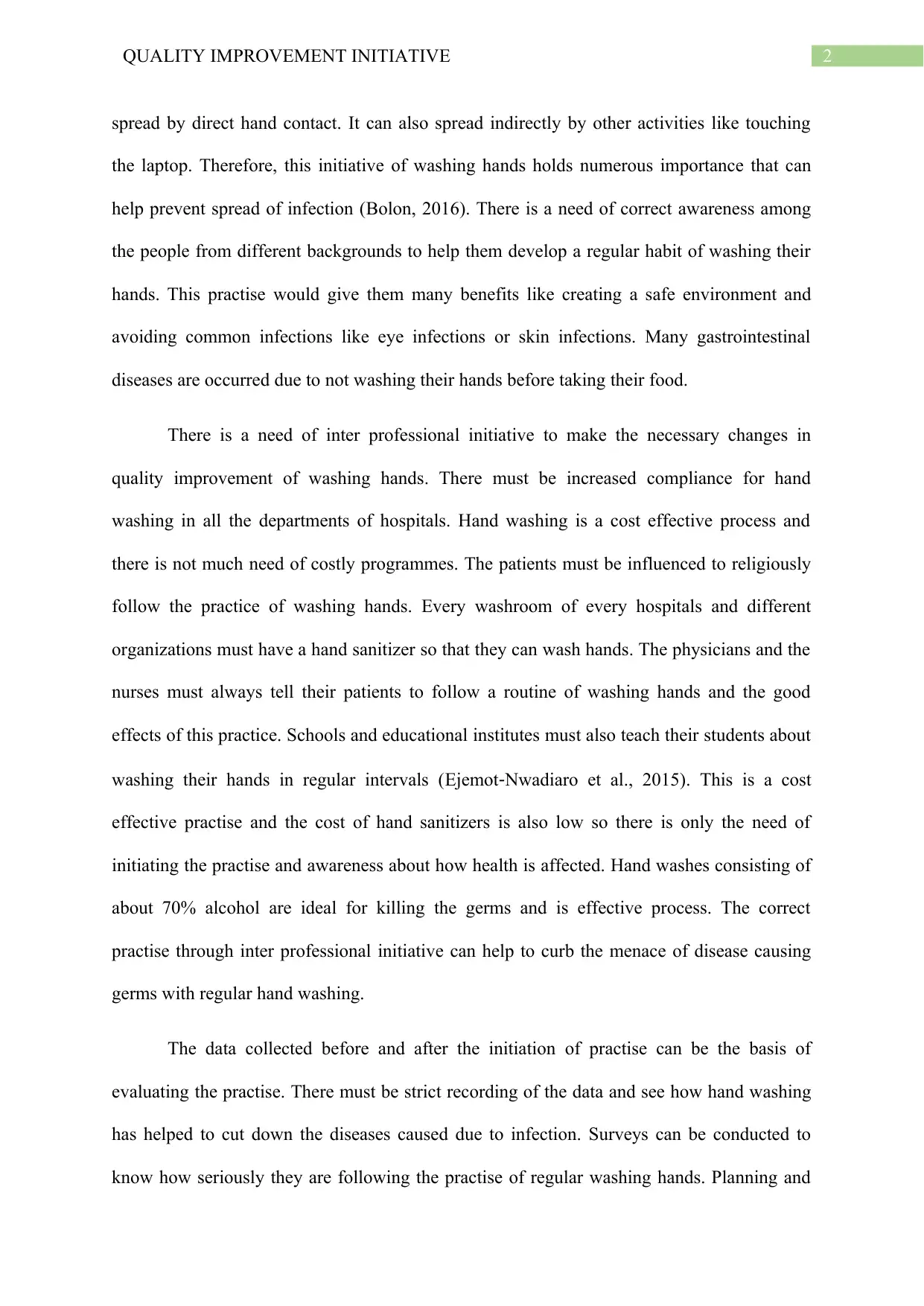
2QUALITY IMPROVEMENT INITIATIVE
spread by direct hand contact. It can also spread indirectly by other activities like touching
the laptop. Therefore, this initiative of washing hands holds numerous importance that can
help prevent spread of infection (Bolon, 2016). There is a need of correct awareness among
the people from different backgrounds to help them develop a regular habit of washing their
hands. This practise would give them many benefits like creating a safe environment and
avoiding common infections like eye infections or skin infections. Many gastrointestinal
diseases are occurred due to not washing their hands before taking their food.
There is a need of inter professional initiative to make the necessary changes in
quality improvement of washing hands. There must be increased compliance for hand
washing in all the departments of hospitals. Hand washing is a cost effective process and
there is not much need of costly programmes. The patients must be influenced to religiously
follow the practice of washing hands. Every washroom of every hospitals and different
organizations must have a hand sanitizer so that they can wash hands. The physicians and the
nurses must always tell their patients to follow a routine of washing hands and the good
effects of this practice. Schools and educational institutes must also teach their students about
washing their hands in regular intervals (Ejemot‐Nwadiaro et al., 2015). This is a cost
effective practise and the cost of hand sanitizers is also low so there is only the need of
initiating the practise and awareness about how health is affected. Hand washes consisting of
about 70% alcohol are ideal for killing the germs and is effective process. The correct
practise through inter professional initiative can help to curb the menace of disease causing
germs with regular hand washing.
The data collected before and after the initiation of practise can be the basis of
evaluating the practise. There must be strict recording of the data and see how hand washing
has helped to cut down the diseases caused due to infection. Surveys can be conducted to
know how seriously they are following the practise of regular washing hands. Planning and
spread by direct hand contact. It can also spread indirectly by other activities like touching
the laptop. Therefore, this initiative of washing hands holds numerous importance that can
help prevent spread of infection (Bolon, 2016). There is a need of correct awareness among
the people from different backgrounds to help them develop a regular habit of washing their
hands. This practise would give them many benefits like creating a safe environment and
avoiding common infections like eye infections or skin infections. Many gastrointestinal
diseases are occurred due to not washing their hands before taking their food.
There is a need of inter professional initiative to make the necessary changes in
quality improvement of washing hands. There must be increased compliance for hand
washing in all the departments of hospitals. Hand washing is a cost effective process and
there is not much need of costly programmes. The patients must be influenced to religiously
follow the practice of washing hands. Every washroom of every hospitals and different
organizations must have a hand sanitizer so that they can wash hands. The physicians and the
nurses must always tell their patients to follow a routine of washing hands and the good
effects of this practice. Schools and educational institutes must also teach their students about
washing their hands in regular intervals (Ejemot‐Nwadiaro et al., 2015). This is a cost
effective practise and the cost of hand sanitizers is also low so there is only the need of
initiating the practise and awareness about how health is affected. Hand washes consisting of
about 70% alcohol are ideal for killing the germs and is effective process. The correct
practise through inter professional initiative can help to curb the menace of disease causing
germs with regular hand washing.
The data collected before and after the initiation of practise can be the basis of
evaluating the practise. There must be strict recording of the data and see how hand washing
has helped to cut down the diseases caused due to infection. Surveys can be conducted to
know how seriously they are following the practise of regular washing hands. Planning and
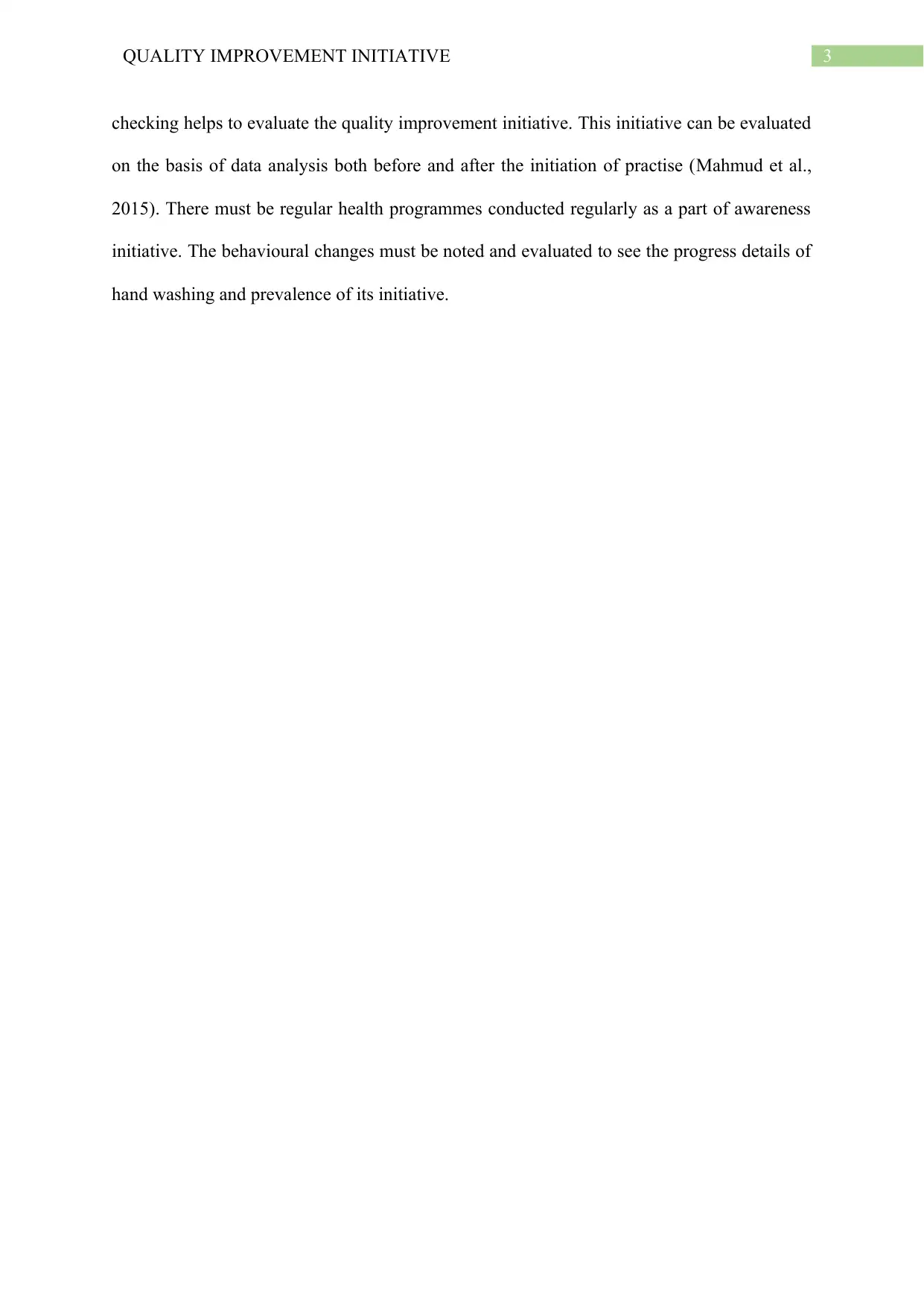
3QUALITY IMPROVEMENT INITIATIVE
checking helps to evaluate the quality improvement initiative. This initiative can be evaluated
on the basis of data analysis both before and after the initiation of practise (Mahmud et al.,
2015). There must be regular health programmes conducted regularly as a part of awareness
initiative. The behavioural changes must be noted and evaluated to see the progress details of
hand washing and prevalence of its initiative.
checking helps to evaluate the quality improvement initiative. This initiative can be evaluated
on the basis of data analysis both before and after the initiation of practise (Mahmud et al.,
2015). There must be regular health programmes conducted regularly as a part of awareness
initiative. The behavioural changes must be noted and evaluated to see the progress details of
hand washing and prevalence of its initiative.
Secure Best Marks with AI Grader
Need help grading? Try our AI Grader for instant feedback on your assignments.
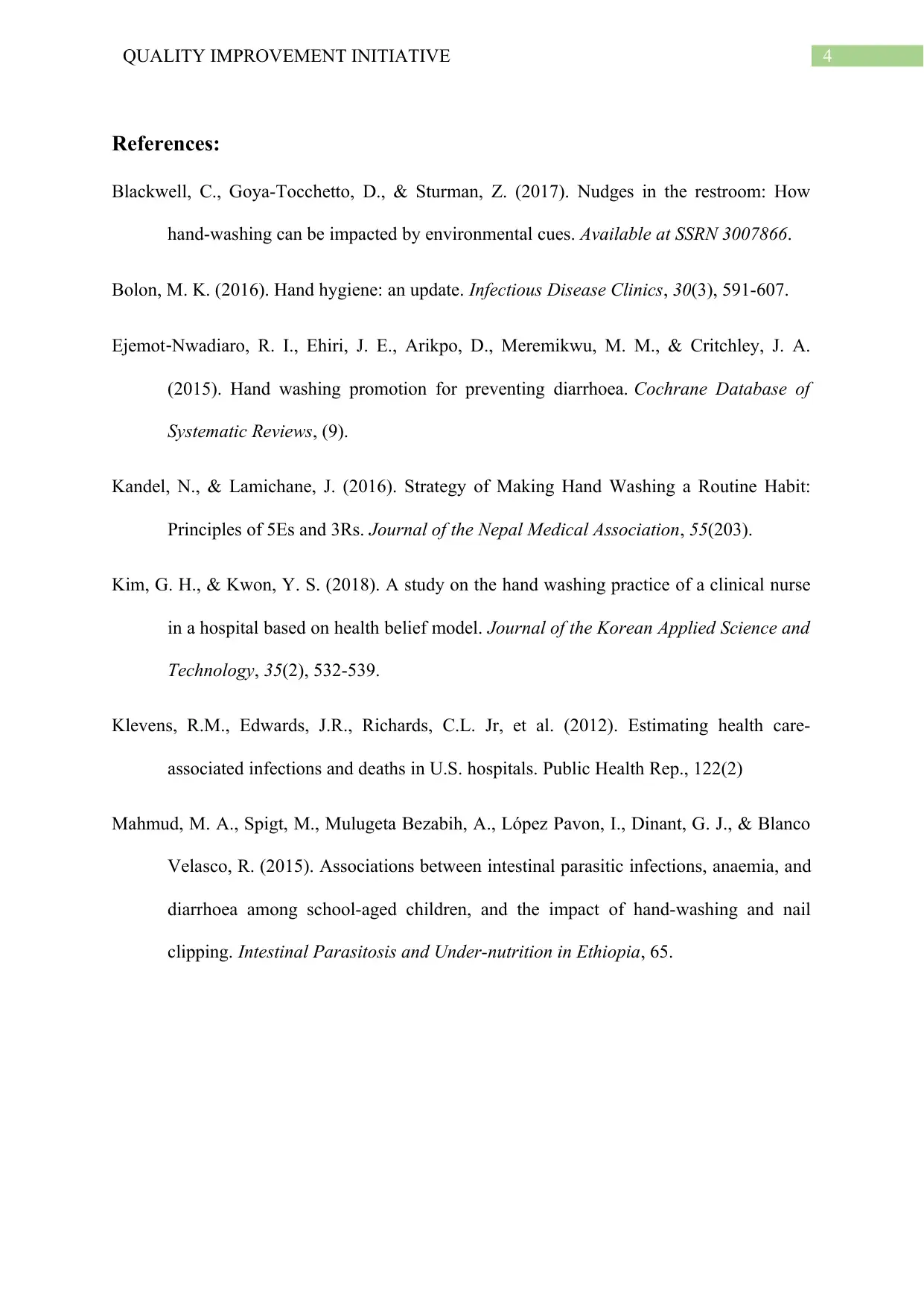
4QUALITY IMPROVEMENT INITIATIVE
References:
Blackwell, C., Goya-Tocchetto, D., & Sturman, Z. (2017). Nudges in the restroom: How
hand-washing can be impacted by environmental cues. Available at SSRN 3007866.
Bolon, M. K. (2016). Hand hygiene: an update. Infectious Disease Clinics, 30(3), 591-607.
Ejemot‐Nwadiaro, R. I., Ehiri, J. E., Arikpo, D., Meremikwu, M. M., & Critchley, J. A.
(2015). Hand washing promotion for preventing diarrhoea. Cochrane Database of
Systematic Reviews, (9).
Kandel, N., & Lamichane, J. (2016). Strategy of Making Hand Washing a Routine Habit:
Principles of 5Es and 3Rs. Journal of the Nepal Medical Association, 55(203).
Kim, G. H., & Kwon, Y. S. (2018). A study on the hand washing practice of a clinical nurse
in a hospital based on health belief model. Journal of the Korean Applied Science and
Technology, 35(2), 532-539.
Klevens, R.M., Edwards, J.R., Richards, C.L. Jr, et al. (2012). Estimating health care-
associated infections and deaths in U.S. hospitals. Public Health Rep., 122(2)
Mahmud, M. A., Spigt, M., Mulugeta Bezabih, A., López Pavon, I., Dinant, G. J., & Blanco
Velasco, R. (2015). Associations between intestinal parasitic infections, anaemia, and
diarrhoea among school-aged children, and the impact of hand-washing and nail
clipping. Intestinal Parasitosis and Under-nutrition in Ethiopia, 65.
References:
Blackwell, C., Goya-Tocchetto, D., & Sturman, Z. (2017). Nudges in the restroom: How
hand-washing can be impacted by environmental cues. Available at SSRN 3007866.
Bolon, M. K. (2016). Hand hygiene: an update. Infectious Disease Clinics, 30(3), 591-607.
Ejemot‐Nwadiaro, R. I., Ehiri, J. E., Arikpo, D., Meremikwu, M. M., & Critchley, J. A.
(2015). Hand washing promotion for preventing diarrhoea. Cochrane Database of
Systematic Reviews, (9).
Kandel, N., & Lamichane, J. (2016). Strategy of Making Hand Washing a Routine Habit:
Principles of 5Es and 3Rs. Journal of the Nepal Medical Association, 55(203).
Kim, G. H., & Kwon, Y. S. (2018). A study on the hand washing practice of a clinical nurse
in a hospital based on health belief model. Journal of the Korean Applied Science and
Technology, 35(2), 532-539.
Klevens, R.M., Edwards, J.R., Richards, C.L. Jr, et al. (2012). Estimating health care-
associated infections and deaths in U.S. hospitals. Public Health Rep., 122(2)
Mahmud, M. A., Spigt, M., Mulugeta Bezabih, A., López Pavon, I., Dinant, G. J., & Blanco
Velasco, R. (2015). Associations between intestinal parasitic infections, anaemia, and
diarrhoea among school-aged children, and the impact of hand-washing and nail
clipping. Intestinal Parasitosis and Under-nutrition in Ethiopia, 65.
1 out of 5
Related Documents
Your All-in-One AI-Powered Toolkit for Academic Success.
+13062052269
info@desklib.com
Available 24*7 on WhatsApp / Email
![[object Object]](/_next/static/media/star-bottom.7253800d.svg)
Unlock your academic potential
© 2024 | Zucol Services PVT LTD | All rights reserved.





